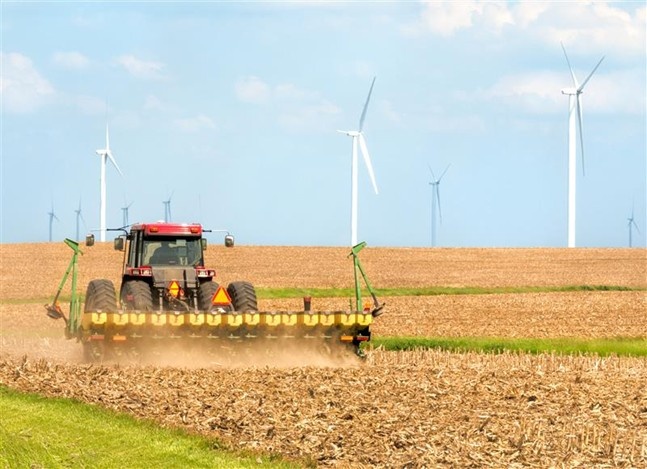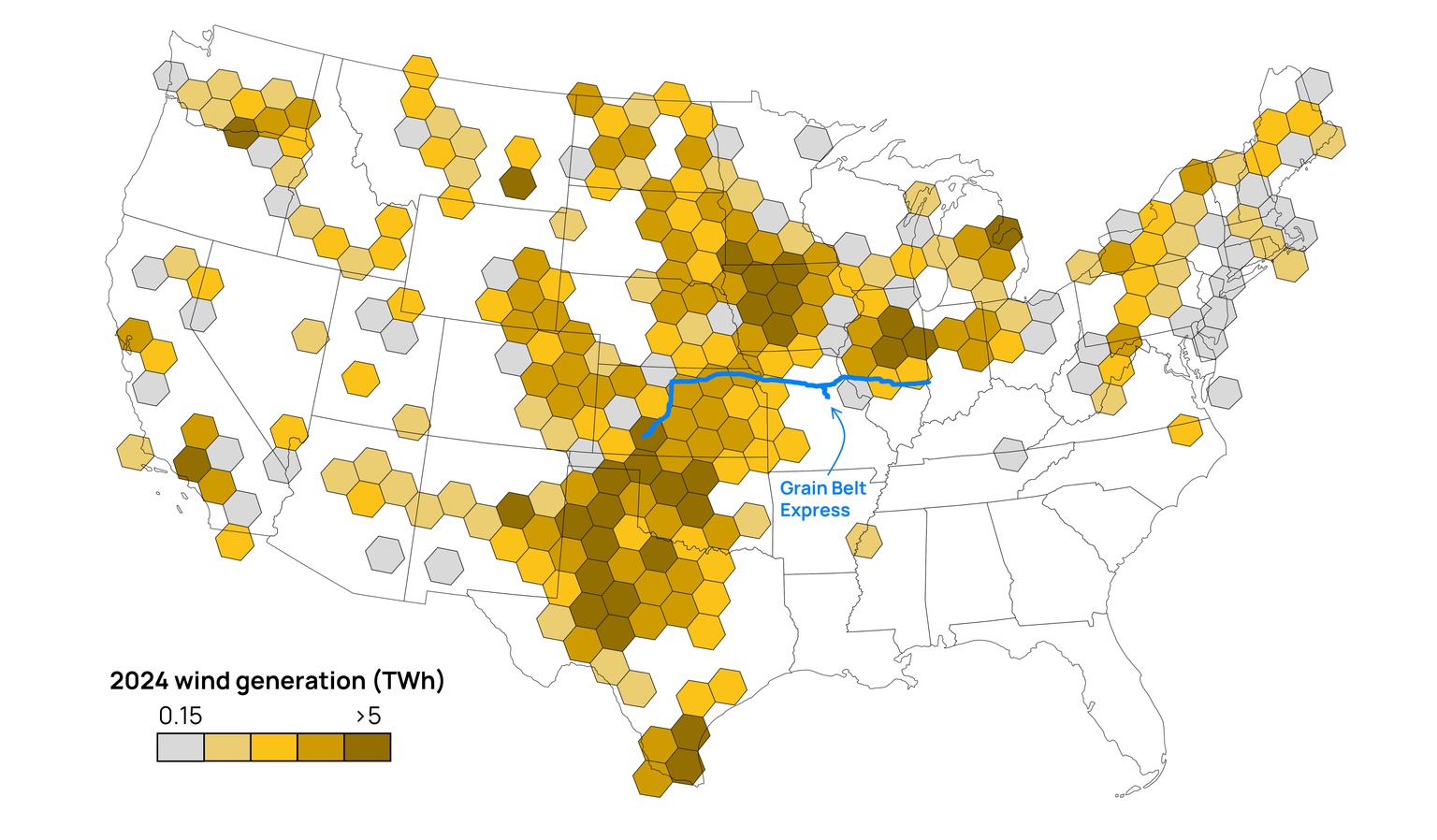
Aaron Foyer
Vice President, Research and Analytics
The reasons behind the cancellation

Aaron Foyer
Vice President, Research and Analytics
The American Midwest is not often thought of as an energy superpower, but it should be. Turbines in Midwestern states generated 50% more electricity from wind than all of Germany last year, itself a global wind superpower.
Few places on Earth match the renewable potential of the winds across the region. At 100 meters above ground, the hub height of many modern turbines, average wind speeds reach 8 meters per second across much of the Midwest, particularly in Kansas, Nebraska and Oklahoma. These levels of high-speed winds over such vast areas of land can only otherwise be found on the Patagonian Steppe, the Eurasian Steppe and the Sahara Desert. What sets the Midwest apart is that its incredible wind resources sit just a few hundred miles from major demand centers.

Farmer seeding soybeans near a wind farm in Illinois // Adobe
The need to build power projects in the region is strong. There are more than 500 gigawatts of power projects in the Midwestern interconnection queue vying for approval to connect to the grid, 87% being wind, solar and batteries.
But bringing those resources to market is tough. The existing transmission system is stressed, with power being increasingly curtailed. The Midcontinent Independent System Operator published a report earlier this year outlining that wind is responsible for half of the regional grid’s congestion, resulting in more than 607 megawatts of power being curtailed per hour on average.
It thus came as a surprise when the Department of Energy revoked its $4.9 billion in loan guarantees from a large high-voltage transmission line last month. The Grain Belt Express was designed to address many of the region’s grid issues and help bring renewable electricity to markets in need. In remarkable irony, the White House released its AI Action Plan hours later, outlining the need to enhance and expand the nation’s electric grid to meet the demand for data centers.
President Donald Trump’s crusade against is wind power is well known. In the lead up to last year’s election, he said of wind farms: “They destroy everything, they’re horrible, the most expensive energy there is. They ruin the environment, they kill the birds, they kill the whales.” Department of Energy (DOE) Secretary Chris Wright expressed his own doubts at CERAWeek earlier this year.
So, how much was the Grain Belt Express’s cancelled loan the act of an administration with a vendetta against wind power?
Let’s plug in and trace the current.
Billed as the largest electric transmission project in US history, the Grain Belt Express is an 800-mile, 600-kilovolt high-voltage direct current transmission line designed to carry up to 5 gigawatts of wind and solar power from Kansas to Illinois and Indiana. The first phase, covering 530 miles from western Kansas to central Missouri, was expected to cost $4.4 billion.

The project has been under development for 15 years, first proposed by Clean Line Energy back in 2010 to connect wind farms in Kansas with more populated areas to the east. The transmission line will also serve the growing number of data centers in the region.
The first signs of trouble: The project quickly ran into resistance as farmers, ranchers and rural landowners were understandably worried about the project’s 150-foot towers marching across their fields. Though they were very vocal opponents, they are a minority. The current project owner, Invenergy, has secured agreements with 97% of landowners along the route to permit the project’s development.
Beyond the energy savings to end customers, which we’ll touch on in a bit, the Grain Belt Express sought a loan from the DOE because a federal stamp of approval would de-risk the project on multiple fronts.
Given how difficult it is to get large energy projects built in North America today, developers often need the federal government as a partner to get important infrastructure across the line. A project is never safer than when Uncle Sam’s holding the checkbook.

Source: Orennia
Having the government on board has a funny way of getting permits approved, handy for a massive multi-jurisdictional transmission line spanning private land across four states. And having government backing gives any project legitimacy, helping to attract private capital.
The details of the loan: Following the Republican sweep of Congress and the presidency, the outgoing leadership of the DOE Loans Program Office (LPO) ran its best 2-minute drill and approved $38 billion in loans prior to new administration taking office. For those keeping score, that’s more than half of all LPO commitments made during the entire Inflation Reduction Act era. The Grain Belt Express received a conditional loan guarantee of up to $4.9 billion from the LPO during this lame duck period.
Part of the conditions of the LPO loan included showing predictable cash flows from binding agreements. This is the snag.
Transmission lines developed by regulated utilities will typically recover project costs by adding a few dollars onto the rate customers pay and so rely on long-term contracts before starting. The large SunZia transmission project being built by Pattern Energy in New Mexico secured offtake before being approved.
The Grain Belt Express instead plans to use a merchant model, a more market-based approach of buyers and sellers of electricity. Adam Smith might be satisfied, but the LPO’s loan conditions weren’t. Engineering News-Record reviewed the transmission line’s regulatory filings and found just 225 megawatts’ worth of non-binding agreements for the project.

Source: Orennia
“After a thorough review of the project’s financials, DOE found that the conditions necessary to issue the guarantee are unlikely to be met and it is not critical for the federal government to have a role in supporting this project. To ensure more responsible stewardship of taxpayer resources, DOE has terminated its conditional commitment,” wrote the Department of Energy in its statement.
And then there’s politics: To say the decision entirely came down the project’s finances would be wrong.
Just days before the loan was cancelled, Missouri Sen. Josh Hawley posted on X, calling on the DOE to cancel the loan. “This administration should stop using taxpayer money to prop up speculative green energy boondoggles,” wrote Hawley. The senator also met with the president days before the loan was cancelled to advocate for the outcome, leaving the meeting with assurances that Energy Secretary Chris Wright “[would] be putting a stop to the Grain Belt Express green scam.”
And Republican resistance to the project goes beyond ending taxpayer support of it. Missouri Attorney General Andrew Bailey pledged to try to block the $11 billion project, even if it loses federal financial support. “I think the project needs to be killed. It doesn’t benefit the people of the state of Missouri. It was sold under false pretenses.”
Supporters of Grain Belt Express have every right to be frustrated by federal and state pushback against the Midwestern transmission project for the contradictions between messaging and policy.
In his first day in office, Trump rightfully declared a national energy emergency, for a lack of overall electricity in the US, including the means to move it. But if the country is in an energy emergency, why make building the largest transmission project in US history more challenging? Especially one in an area, as we’ve said already, with 607 megawatts of power being curtailed per hour on average because of transmission congestion.

Source: Orennia
It also goes against the president’s campaign promise to reduce energy costs for consumers. “We’re going to get your energy prices down by 50%,” pledged Trump at a campaign rally in Pennsylvania last year. Yet, it will be consumers who are burdened with higher energy costs if the transmission line doesn’t get built.
Analysis from energy analyst Justin Chandler estimates that just by swapping out a low-interest federal loan with higher interest loans from the private sector the cost for consumers will jump by $6 per megawatt-hour. That’s if it gets built. If it doesn’t, the Illinois Power Authority pegs the additional cost for consumers at $51.9 billion over 15 years, including $6 billion for Missourians. A far cry from Sen. Hawley’s view that “Missouri was gonna get just about nothing” from the line.
The DOE eliminating the federal loan won’t necessarily kill the Grain Belt Express, but not having the backing of the federal government makes it tougher.
While 97% of the landowners on its route have given the project their blessing, eminent domain may be needed to access the remaining 3%. And with senators, attorney generals and the Secretary of Energy all skeptical of the project to begin with due to its association with wind, that could be an uphill battle.
Branding US: Right now, given surging power demand for AI, the US needs the Trump administration to show it’s the best place in the world to invest, especially for energy.
Sure, the DOE can probably justify its claim that the project has higher levels of financial risk than it was willing to accept. But cancelling the loan in the abrupt and seemingly ideologically motivated way the DOE presented it signals to investors that transmission risk is political risk, adding capital costs to projects. Those extra costs, of course, are passed along to consumers via higher energy prices. It will also make the 18.5 gigawatts of gas power projects and 16.2 gigawatts of data centers being developed between the four states more difficult to advance.
And lest we paint the Republicans as the only ideologically motivated party that cancels important energy projects, on the first day of the last administration, one of President Joe Biden’s first moves was to cancel the Keystone XL pipeline that could have cemented North American energy security.
Bottom line: As Republican Sen. Chuck Grassley of Iowa put it, “Cean energy… is a critical tool for American energy independence.”
The winds of the Midwest are one of the great energy resources of the world, capable of both lowering electricity prices and powering data centers. No need to cut off your nose to spite your face.
Data-driven insights delivered to your inbox.